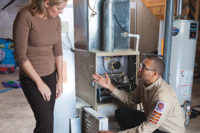All that is changing with the Energy Star for New Homes version 3, and I think it’s a good thing. The two biggest things that make this version of the program stronger are the requirement that contractors follow the Quality Installation (QI) standard and the need to have the installation verified by a rater.
Following the QI standard helps contractors install properly sized units in homes. This enables the installed units to run as efficiently as possible, which establishes a baseline for future maintenance. Think about it: If everyone were following this standard, the number of call backs from customers would be virtually eliminated. And that would make for lots of happier customers, allowing contractors to focus on preventive maintenance, routine maintenance, and upgrades.
The rater verification is what helps confirm that contractors are following the QI standard. In the past, installation was all about who could do it fastest and cheapest. There wasn’t a lot of analyzing how the house performed, and there wasn’t any verification that things were done right. Now, in order for the house to get that Energy Star label, the contractor’s work must be verified by a third-party rater. To put it simply, there will be someone to check the completed work, ensuring it has been done to the highest standard.
JUMP IN
So, why should you even be concerned with any of this? Well, if you do any work on new homes that intend to be Energy Star rated, you will have to follow these rules, and you will have to be recognized as a Quality Assurance (QA) contractor. And if you don’t do new home work, I think these standards will soon be required for existing homes, so why not start preparing for that now?Becoming a QA contractor is not a hard process, but it takes some time. I recommend starting yesterday - or right now. Make the decision to do the right things and jump in because this is mandatory for any contractor working on new homes that are finished in 2012 and beyond.
For some contractors, gaining the QA recognition won’t be a very long process because they are already following the QI standard. If you fall into this category, you just need to put the pieces together. Take the orientation course, submit the application, and pay the fees.
Other contractors, however, will need some training. I suggest contacting the Air Conditioning Contractors of America (ACCA) to help with the training.
After you have been trained, seek out help from other partners in the Energy Star program, namely, homebuilders and raters. This program requires teamwork, so start building relationships with these businesses right away. This will make the Energy Star process better for everyone involved.
There is really no reason for any contractor who works on new homes not to become QA-recognized. The time it takes will pay big dividends in the long run. Because let’s face it, the economy is not going to stay down forever. When it starts to shoot up, homeowner expectations are going to continue to rise. And we don’t want the HVAC system to end up being the reason those homeowners are dissatisfied.
Now is the time for contractors to stop running from this progress and embrace it. Will you join me as a QA contractor?
Sidebar: QA Is Coming
The Air Conditioning Contractors of America (ACCA) recently launched its new Quality Assured (QA) Contractor Recognition Program to support the EPA’s Energy Star for New Homes Program Version 3. To earn an Energy Star rating, a new home must meet specific energy efficiency guidelines; including improved requirements for the HVAC system.Starting Jan. 1, 2012, any finished home that is intended for an Energy Star rating must have an HVAC system that was installed to the ACCA QI Standard by a QA-recognized contractor. This means that even if the HVAC work is done on the house in 2011, but the house is not finished until Jan. 1, 2012, the HVAC system must be installed by a QA-recognized contractor. For a home to be considered finished, it must have received its certificate of occupancy by the code official or had the final RESNET rater inspection completed.
To participate in the program, you must satisfy these requirements:
• Participate in the online orientation course that outlines the EPA Energy Star New Homes Program, as well as the ACCA QA program.
• Implement written policies, follow procedures, and observe industry practices specified in the QA Participant’s Requirements and QA Elements.
• Apply online and pay required fees. ACCA is currently offering a 50 percent discount on the first year’s annual fees through June 30, 2011.
To help you understand and satisfy these requirements, ACCA has put together a website, www.acca.org/qa, that will answer your questions. You can even take the orientation course from this site, so you don’t have to spend any additional time or money for travel.
ACCA encourages all contractors who work on new homes to begin the process of becoming a QA contractor now.
For questions about the program or how to get started, email Wes Davis at wes.davis@acca.org.
Publication date:06/27/2011






